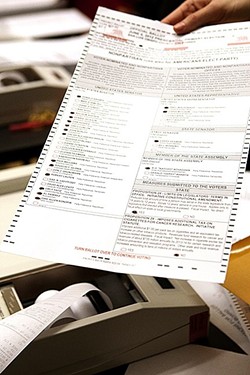[{
"name": "Ad - Medium Rectangle CC01 - 300x250",
"id": "AdMediumRectangleCC01300x250",
"class": "inlineCenter",
"insertPoint": "8",
"component": "2963441",
"requiredCountToDisplay": "12"
},{
"name": "Ad - Medium Rectangle LC01 - 300x250",
"id": "AdMediumRectangleCC01300x250",
"class": "inlineCenter",
"insertPoint": "18",
"component": "2963441",
"requiredCountToDisplay": "22"
},{
"name": "Ad - Medium Rectangle LC09 - 300x250",
"id": "AdMediumRectangleLC09300x250",
"class": "inlineCenter",
"insertPoint": "28",
"component": "3252660",
"requiredCountToDisplay": "32"
}]
Despite being on a short list of counties allowed to immediately implement a new state election model geared toward mail-in voting, San Luis Obispo County has decided it will stick with the status quo for the 2018 elections, citing technical and logistical challenges.
The Voter's Choice Act, or Senate Bill (SB) 450, passed by the state Legislature last year, introduces a new election system—based on a model in Colorado—that replaces traditional Election Day precinct polls with a small number of "vote centers" open to the public as early as 10 days before Election Day, which can serve as registration locations for voters.
Pitched as a way to improve voter accessibility and turnout, under the model every registered voter receives a ballot in the mail one month before the election, which they could turn in at their leisure—an option that more and more state voters are preferring anyway.
Fifty-eight percent of Californians voted by mail in the last election, up from 42 percent in 2006, and 20 percent in 1996. The early voting trend is even more prevalent in SLO County, where 70 percent of county voters submitted mail-in ballots last year.
SLO County Clerk-Recorder Tommy Gong said that was one of the reasons why he asked the state if SLO could be included among the 14 counties eligible to test the model for the 2018 elections.
"I was interested," Gong told New Times. "We're at a point where 70 percent of our people are voting by mail. It could certainly lend itself to the vote center model rather than preparing all the precinct sites."
Gong's office runs 137 precincts on Election Day across the county, manned by about 1,000 poll workers. The SB 450 election model would require operating only 17 to 20 vote centers, open to any citizen regardless of their city, town, or neighborhood.
But after eight months of analysis, Gong said he found that the technical infrastructure needed for the vote centers—like secure, uninterrupted connectivity to state and local voter registration databases—was substantially more robust than what the county currently rolls out at its precinct sites. The county actually needs to replace basic election infrastructure, like its vote tabulation system, which is 18 years old.
"Last November all 139,685 ballots were fed by hand," Gong said.
Other logistical challenges about SB 450 arose, like the viability of occupying up to 20 community centers in high-demand for multiple days.
Gong concluded that the county couldn't implement the system with the June 2018 primaries just around the corner. He said it will be revisited in 2020, when all state counties will be allowed to use the model.
"It's just too short a timeline to be able to implement it all," he said. "We still had unanswered questions."
More or less accessible?
As part of the decision-making process, Gong organized a focus group of diverse community stakeholders to discuss implementing SB 450 in 2018.
The group met four times over the summer and included representatives from the Democratic and Republican central committees; the League of Women Voters; Cal Poly; the Coalition of Labor, Agriculture, and Business (COLAB); the Latino Outreach Council; and others.
"They were pretty darn good meetings," Gong said.
Proponents of SB 450, like Rosemary Canfield, chair of the SLO County Democratic Central Committee, believe that the vote centers, by being open for 10 days, would make elections more accessible and accommodating to people of "all walks of life."
"I'm disappointed that we didn't get to take advantage of it for this upcoming election," Canfield said. "I think it is a more inclusive way for people to exercise their civil right to vote. It makes it less of a burden on pretty much everybody."
Among the opponents of rolling out SB 450 in 2018 was Laura Mordaunt, secretary for the Republican Party of SLO County and member of the SB 450 focus group.
In a Sept. 11 open letter to local and state representatives, Mordaunt warned that the new model could confuse and disenfranchise voters, citing a 2016 UC Davis survey where several voting groups, including minorities, expressed distrust about the system.
"SB 450 is a radical restructuring of California's election process," Mordaunt stated. "A substantial percentage of the public prefers precinct voting as a backup system. ... I have grave concerns that 2018 implementation will result in substantial disenfranchisement of voters." Δ
Contact Staff Writer Peter Johnson at [email protected].
Latest in News
Readers also liked…
-

Coast Unified teachers upset over new position's salary and qualifications
Oct 20, 2022 -

SLO police identify alleged driver who hit and killed couple
Dec 22, 2022 -

When the levee breaks: Oceano residents, county officials walk a tightrope of regulations to manage Arroyo Grande Creek, which some say led to the levee's failure in January
May 18, 2023










